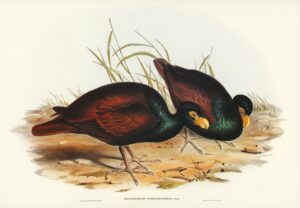Treasure has many definitions, but I think most of us imagine something shiny and rare when we think of the word. The De Winton’s golden mole — a species recently rediscovered after missing, presumed extinct for 87 years — fits both descriptions. Behold this absolute beauty.

A De Winton’s golden mole. Once lost, now found. Photo: Nicky Souness
Okay, beauty is in the eye of the beholder. But you can’t deny that the golden mole has a certain iridescent charm that ranks highly on the mole scale of attractiveness. Particularly because this is the first one anyone’s seen since 1936.
A team from the Endangered Wildlife Trust (EWT) and the University of Pretoria tracked down the elusive creature after painstakingly sifting through 100 soil samples from Port Nolloth Beach in South Africa, the only place the golden diggers had ever been spotted.
eDNA breakthrough
The scientists used a burgeoning but promising technique called environmental DNA (eDNA). They extracted biological material from an 18km stretch of dunes, sequenced it, and compared it to DNA from archival specimens of golden mole. It’s similar to a technique scientists are using to identify polar bears on the other end of the planet.
“Extracting DNA from soil is not without its challenges, but we have been honing our skills and refining our techniques, even before this project,” said Samantha Mynhardt, conservation geneticist with the Endangered Wildlife Trust and Stellenbosch University in a press release. “We were fairly confident that if De Winton’s golden mole was [there], we would be able to detect it by finding and sequencing its DNA.”
The search took two years and lots and lots of scientific know-how to pull off. Scent detection dogs and interviews with locals also helped. It’s all part of an initiative called Search for Lost Species — a program that ranks among the most hopeful this science writer has yet to come across.
Lost and Found
If you thought this story couldn’t get any better, you’re wrong. The Search for Lost Species (SLS) is funded by re:Wild, a conservation initiative founded by Global Wildlife Conservation and actor Leonardo DiCaprio. And it’s pretty successful, as far as these things go.
SLS has identified 2,200 lost species across 160 countries that might still be out there. Since 2017, the program has found 11. That might not sound like a lot, but these days, I’ll take whatever good news I can find.
Other species recently found by the program include Attenborough’s long-beaked echidna, the Pernambuco holly, Jackson’s climbing salamander, Wallace’s giant bee, the velvet pitcher plant, the silver-backed chevrotain (a small, deer-like mammal), and more.
There’s no doubt that human technology has contributed to the loss of many species. But now our technology is helping us find some that we thought we lost. That’s exciting to everyone — especially the scientists working on the front line.
“The search for De Winton’s golden mole was not easy by any means,” said Christina Biggs, manager for the Search for Lost Species. “It really speaks to how persistent, thorough, and resourceful the EWT team was in the field. They left no sandhill unturned. Now it’s possible to protect the areas where these threatened and rare moles live.
“The eDNA technique…can [now] be utilized to find other lost species.”






